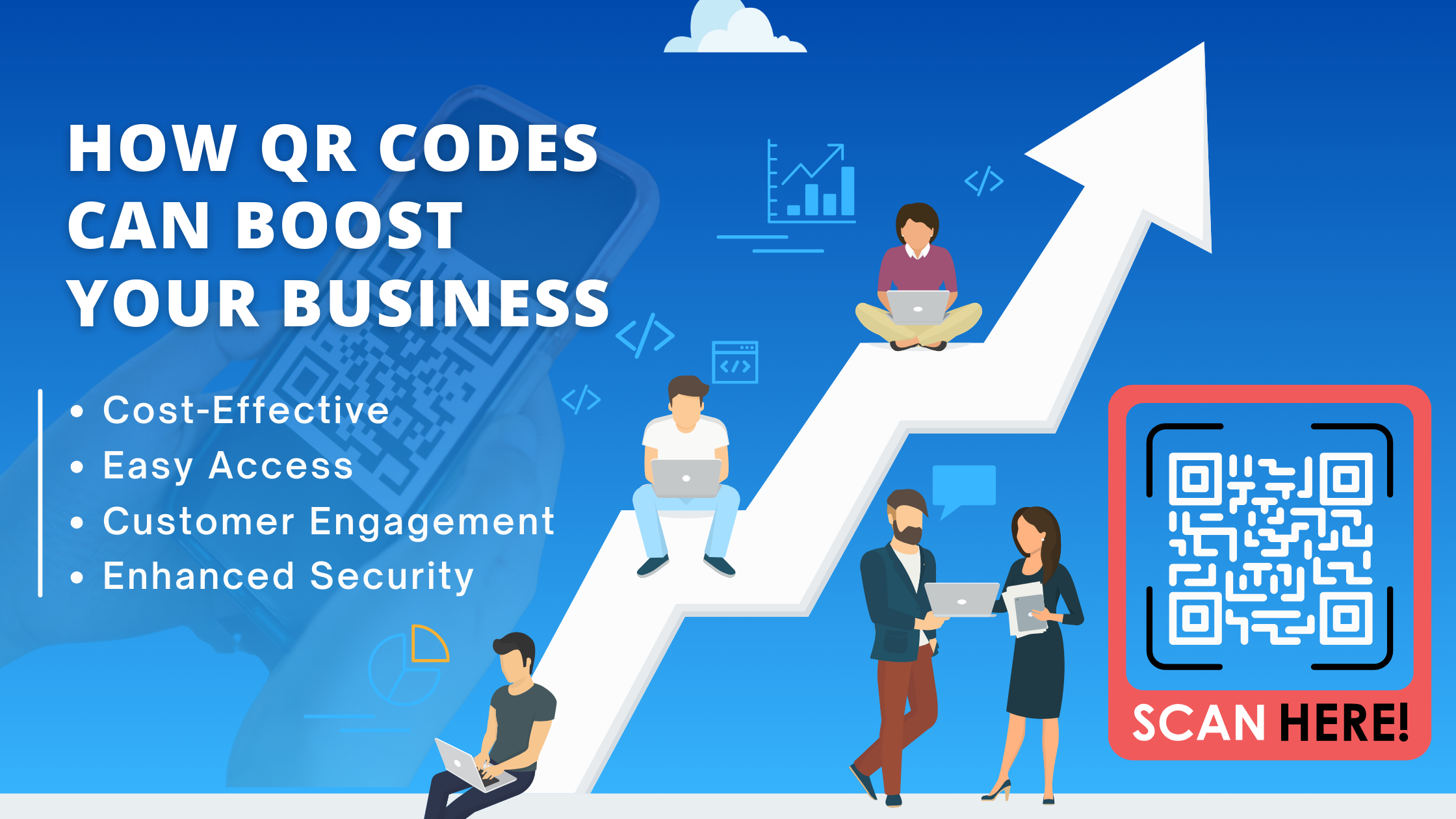Introduction
QR codes have made a remarkable comeback, proving to be more than just a fleeting tech trend. In today’s fast-paced digital world, these tiny squares are transforming how businesses interact with their customers, offering a seamless bridge between the physical and digital realms. But how exactly can QR codes boost your business? Let’s dive in and explore.
What are QR Codes?
QR codes, short for Quick Response codes, are two-dimensional barcodes that can store a wealth of information. Invented in 1994 by Denso Wave, a subsidiary of Toyota, QR codes were initially used for tracking automobile parts. Their ability to store data and be scanned quickly has since made them a versatile tool across various industries.
How QR Codes Work
QR codes work by encoding information such as URLs, text, or other data into a pattern of black and white squares. When scanned by a smartphone or QR code reader, the encoded information is quickly decoded, directing the user to the intended content. It’s like opening a door to a world of information with just a simple scan.
Benefits of Using QR Codes for Businesses
1. Enhancing Customer Engagement
QR codes can significantly enhance customer engagement by providing instant access to information, promotions, and interactive content. Imagine a customer scanning a QR code on a product label and being taken to a video tutorial or a discount coupon. This immediate interaction can create a more engaging and memorable experience.
2. Easy Access to Information
One of the biggest advantages of QR codes is their ability to provide easy and instant access to information. Whether it’s product details, user manuals, or event schedules, QR codes eliminate the need for customers to manually type URLs or search for information online.
3. Cost-Effective Marketing Tool
For businesses looking to maximize their marketing budget, QR codes offer a cost-effective solution. They can be printed on virtually anything—flyers, posters, business cards, packaging—without any significant additional cost. Plus, with dynamic QR codes, you can update the linked content without reprinting the code.
Types of QR Codes
Static vs. Dynamic QR Codes
There are two main types of QR codes: static and dynamic. Static QR codes are fixed and cannot be edited once generated. They are ideal for simple applications like linking to a website. Dynamic QR codes, on the other hand, can be edited and updated, making them perfect for campaigns where the linked content might change over time.
Examples of Use Cases
- Static QR Codes: Business cards, product labels, and promotional materials.
- Dynamic QR Codes: Event tickets, feedback forms, and promotional campaigns.
Implementing QR Codes in Marketing Strategies
Adding QR Codes to Print Media
Integrating QR codes into print media can breathe new life into traditional marketing methods. Add QR codes to brochures, posters, or even direct mail to provide an interactive element that captures the audience’s attention. This hybrid approach combines the tangible appeal of print with the dynamic potential of digital.
Integrating QR Codes with Digital Marketing
In digital marketing, QR codes can be used in email campaigns, social media posts, and websites. For instance, a QR code in an email newsletter can lead recipients to a special landing page or a social media campaign. This integration helps track the effectiveness of digital efforts and provides a seamless user journey.
QR Codes and Customer Experience
Streamlining Transactions
QR codes can streamline transactions, making the shopping experience faster and more efficient. For example, restaurants use QR codes for menus and ordering, reducing wait times and enhancing customer satisfaction. Retailers can use them for self-checkout options, minimizing queues and improving the shopping experience.
Personalized Customer Interactions
With QR codes, businesses can offer personalized interactions based on customer preferences and behaviors. By scanning a QR code, customers might receive tailored recommendations or exclusive offers, fostering a sense of connection and loyalty.
QR Codes for Payments
Contactless Payments
In the wake of the COVID-19 pandemic, contactless payments have surged in popularity. QR codes facilitate this by allowing customers to make payments using their smartphones. This not only enhances safety but also speeds up the checkout process.
Benefits for Both Businesses and Customers
For businesses, QR code payments reduce the need for physical payment terminals and can lower transaction costs. Customers enjoy the convenience of quick and secure payments, improving their overall shopping experience.
Tracking and Analytics
Measuring QR Code Performance
One of the often-overlooked advantages of QR codes is their ability to provide detailed analytics. Businesses can track how many times a QR code has been scanned, the time and location of scans, and even the type of device used. This data is invaluable for assessing the success of marketing campaigns and making data-driven decisions.
Using Data for Marketing Insights
The analytics gathered from QR codes can offer deep insights into customer behavior and preferences. By analyzing this data, businesses can fine-tune their marketing strategies, target their audience more effectively, and ultimately drive better results.
Designing Effective QR Codes
Best Practices for QR Code Design
Creating an effective QR code involves more than just generating the code itself. Consider the following best practices:
- Size and Placement: Ensure the QR code is large enough to be easily scanned and placed in a visible location.
- Contrast and Color: Use high-contrast colors for better readability. Avoid using colors that blend into the background.
- Call to Action: Include a clear call to action (e.g., “Scan here for a discount!”) to encourage engagement.
Tools for Creating QR Codes
There are numerous tools available for creating QR codes, ranging from free online generators to advanced software with customization options. Some popular tools include:
- D-code
- QR Code Generator
- QRCode Monkey
Security Considerations
Preventing QR Code Fraud
As with any technology, QR codes are not immune to misuse. To prevent QR code fraud, ensure that your codes are generated and hosted securely. Educate your customers to only scan codes from trusted sources and verify the authenticity of the link.
Ensuring Customer Safety
Customer safety should be a top priority when using QR codes. Implementing HTTPS links and regularly monitoring the security of your QR codes can help protect users from malicious redirects and phishing attempts.
Future Trends in QR Code Technology
Innovations on the Horizon
As technology evolves, so do QR codes. Future trends include:
- Augmented Reality (AR): Combining QR codes with AR for immersive experiences.
- IoT Integration: Using QR codes in smart devices for seamless connectivity.
- Enhanced Analytics: More sophisticated tracking and data analysis capabilities.
- Copy proof QR codes
The Role of QR Codes in the Evolving Digital Landscape
In an increasingly digital world, QR codes will continue to play a vital role in connecting physical and digital experiences. Their versatility, ease of use, and ability to provide real-time information make them an indispensable tool for businesses aiming to stay ahead in the digital age.
Conclusion
QR codes are a powerful yet underutilized tool that can significantly boost your business. From enhancing customer engagement and streamlining transactions to providing valuable analytics and improving marketing strategies, the benefits of QR codes are vast. By understanding and implementing QR codes effectively, you can create a more connected and efficient experience for your customers, driving your business towards greater success.
FAQs
1. How can I create a QR code for my business?
You can create a QR code using online generators like QR Code Generator, Canva, or Beaconite. These tools allow you to customize the code with your logo, colors, and desired content.
2. Are QR codes safe to use?
Yes, QR codes are safe to use if they are generated and hosted securely. Always ensure that the QR codes you scan or distribute come from trusted sources to avoid fraud.
3. Can QR codes be used for payments?
Absolutely! QR codes are widely used for contactless payments. Platforms like PayPal, Venmo, and many banks support QR code payments, offering a secure and convenient way to complete transactions.
4. What information can a QR code store?
QR codes can store various types of information, including URLs, text, contact details, email addresses, and more. The type of information depends on the use case and the QR code generator used.
5. How can I track the performance of my QR codes?
To track QR code performance, use dynamic QR codes with analytics capabilities. These allow you to monitor the number of scans, user locations, and other valuable metrics to assess the success of your QR code campaigns.




